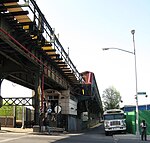Eastern Parkway station
Brooklyn railway station stubsDefunct BMT Fulton Street Line stationsDefunct New York City Subway stations located abovegroundFormer elevated and subway stations in BrooklynRailway stations closed in 1918 ... and 1 more
Railway stations in the United States opened in 1889
Eastern Parkway was a station on the demolished BMT Fulton Street Line in Brooklyn, New York City. It had 2 tracks and 1 island platform and was served by trains of the BMT Fulton Street Line. The station was opened on November 18, 1889, one of three other stations along the line to open on that date. The next stop to the east was Pennsylvania Avenue. The next stop to the west was Atlantic Avenue, which it was in close proximity to. It was even closer to the still existing Sutter Avenue Station on the BMT Canarsie Line. It closed on November 17, 1918, and was replaced by Hinsdale Street Station.
Excerpt from the Wikipedia article Eastern Parkway station (License: CC BY-SA 3.0, Authors).Eastern Parkway station
Van Sinderen Avenue, New York Brooklyn
Geographical coordinates (GPS) Address Nearby Places Show on map
Geographical coordinates (GPS)
| Latitude | Longitude |
|---|---|
| N 40.67348 ° | E -73.902947 ° |
Address
Van Sinderen Avenue 159
11207 New York, Brooklyn
New York, United States
Open on Google Maps






